Abstract
Six bacterial strains able to use 4-fluorobenzoic acid as their sole source of carbon and energy were isolated by selective enrichment from various water and soil samples from the Stuttgart area. According to their responses in biochemical and morphological tests, the organisms were assigned to the genera Alcaligenes, Pseudomonas, and Aureobacterium. To elucidate the degradation pathway of 4-fluorobenzoate, metabolic intermediates were identified. Five gram-negative isolates degraded this substrate via 4-fluorocatechol, as described in previous studies. In growth experiments, these strains excreted 50 to 90% of the fluoride from fluorobenzoate. Alcaligenes sp. strains RHO21 and RHO22 used all three isomers of monofluorobenzoate. Alcaligenes sp. strain RHO22 also grew on 4-chlorobenzoate. Aureobacterium sp. strain RHO25 transiently excreted 4-hydroxybenzoate into the culture medium during growth on 4-fluorobenzoate, and stoichiometric amounts of fluoride were released. In cell extracts from this strain, the enzymes for the conversion of 4-fluorobenzoate, 4-hydroxybenzoate, and 3,4-dihydroxybenzoate could be detected. All these enzymes were inducible by 4-fluorobenzoate. These data suggest a new pathway for the degradation of 4-fluorobenzoate by Aureobacterium sp. strain RHO25 via 4-hydroxybenzoate and 3,4-dihydroxybenzoate.
Full text
PDF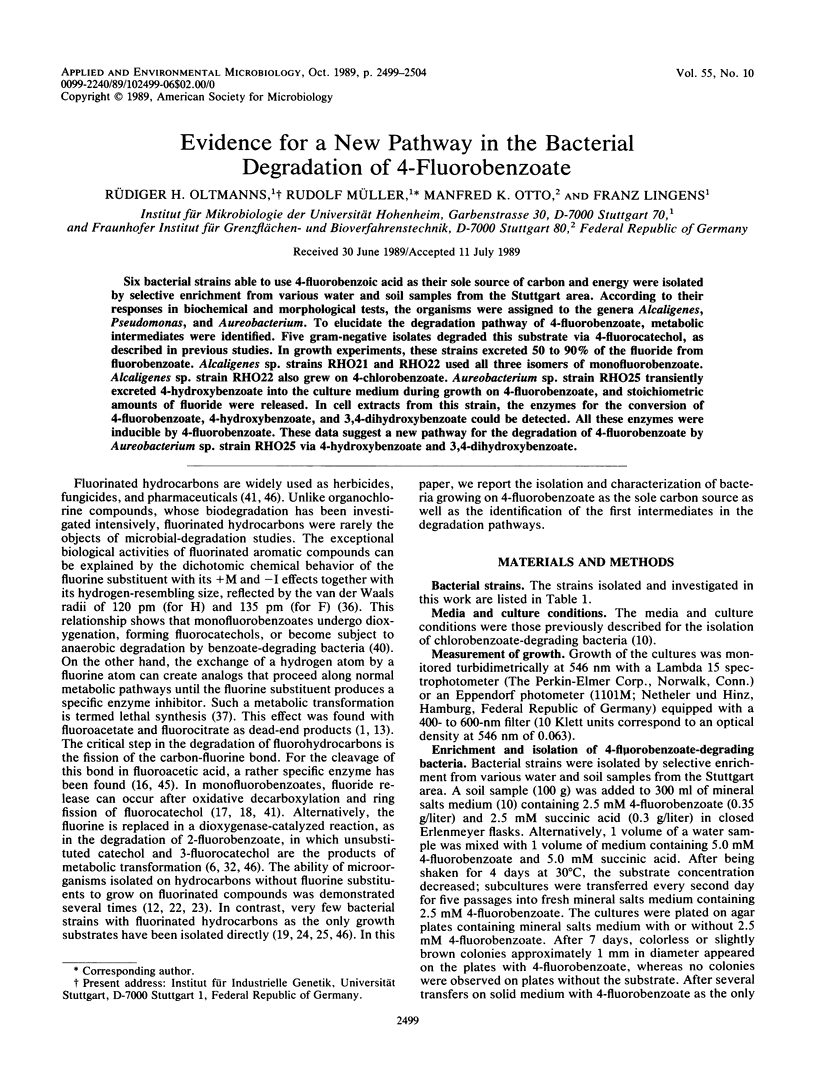
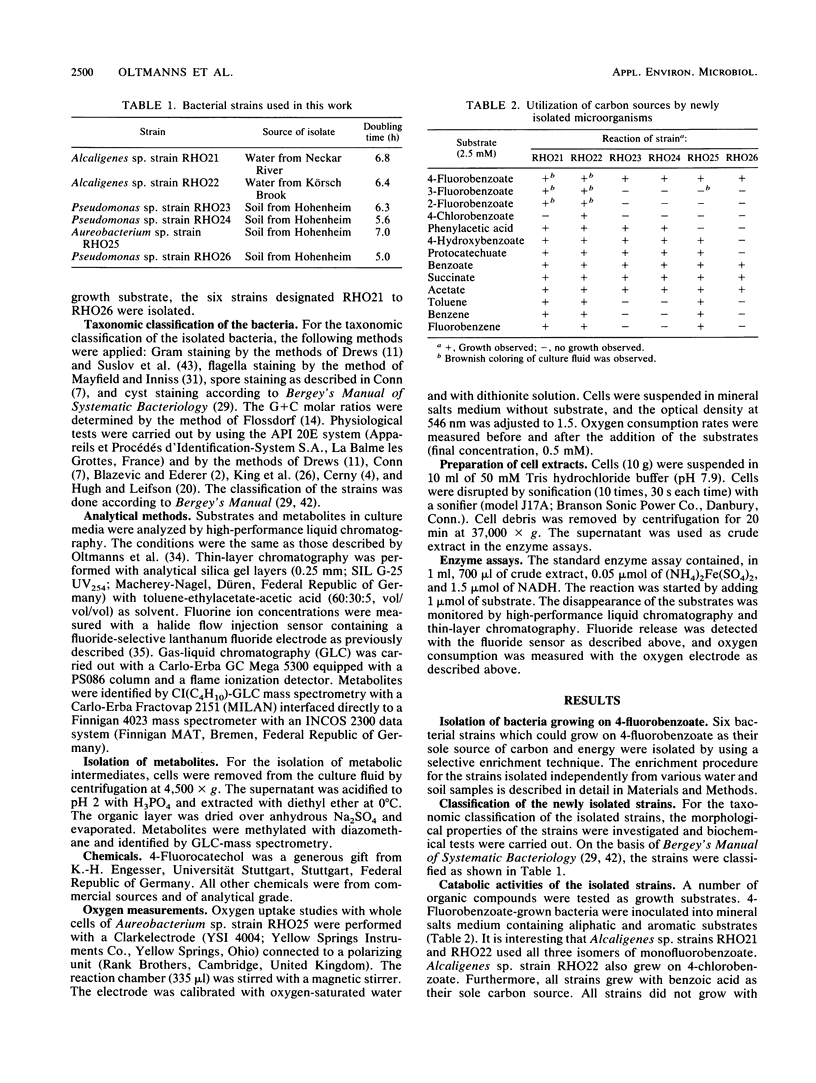
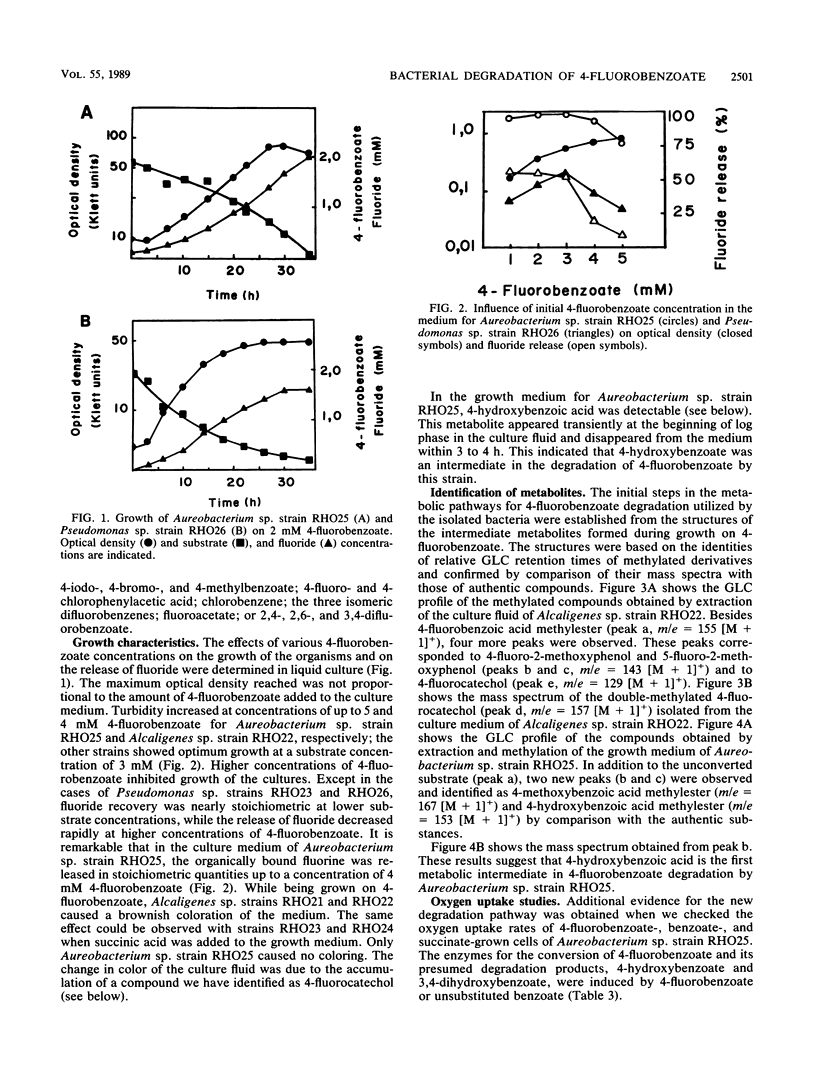
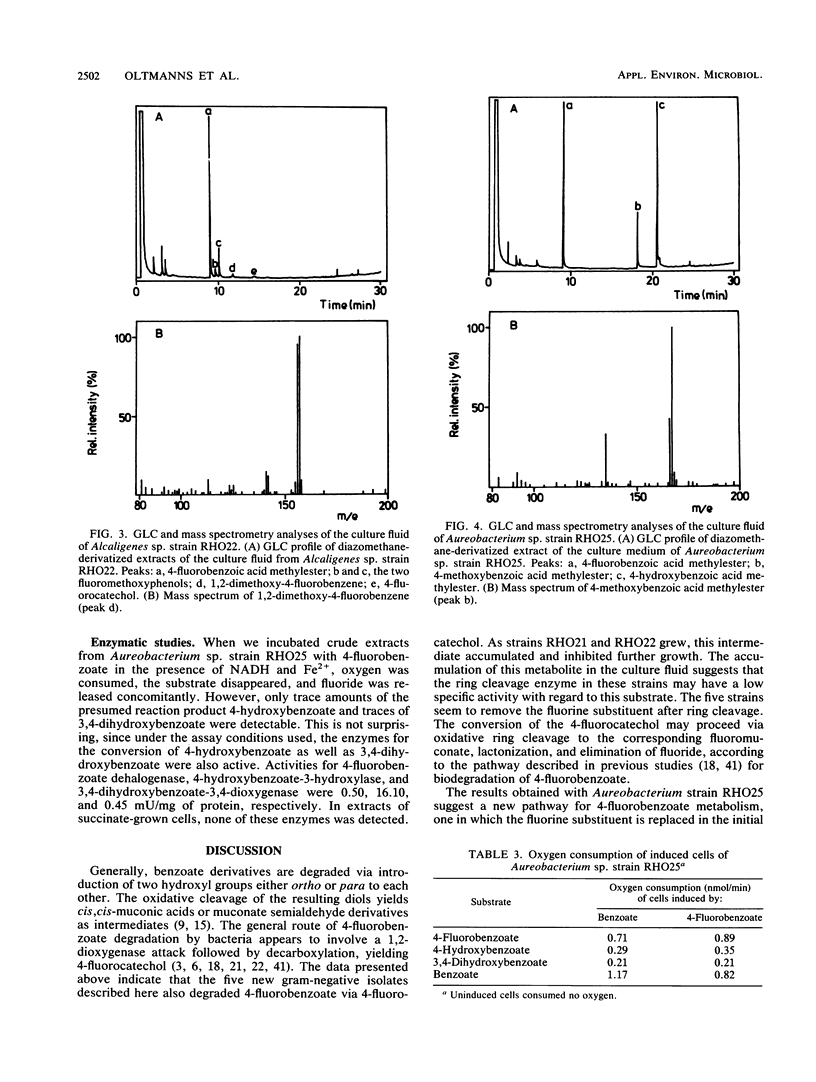
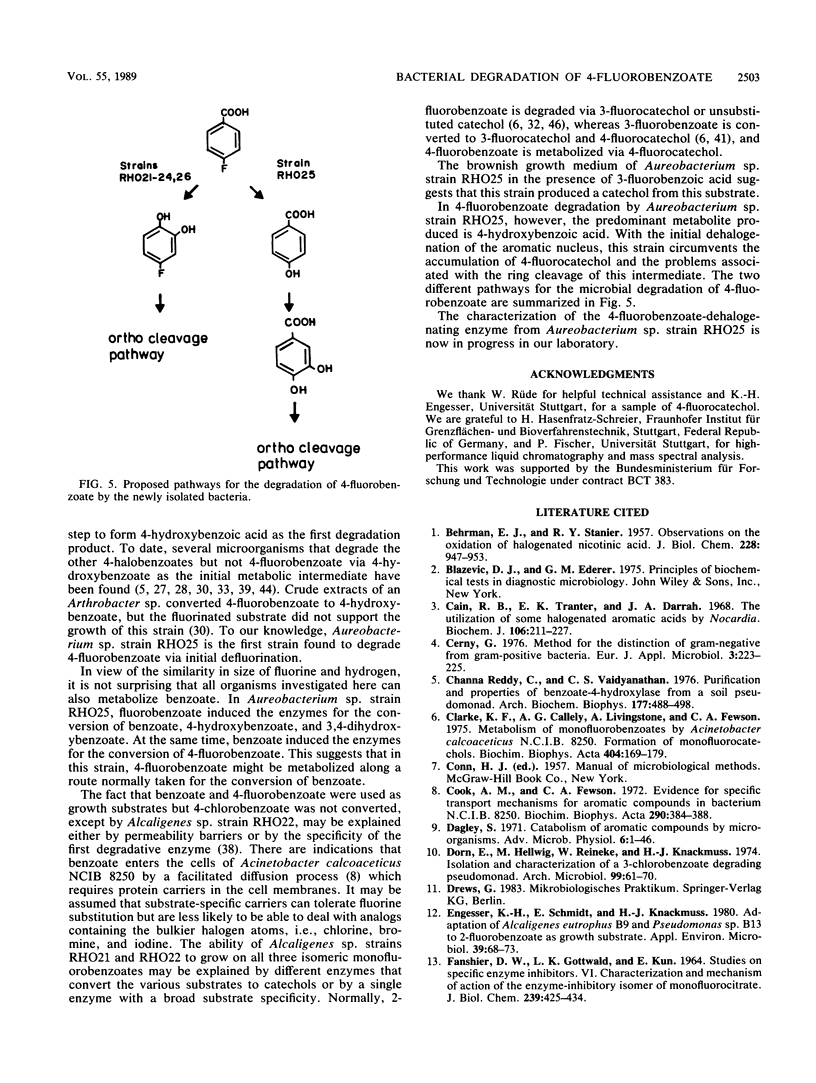
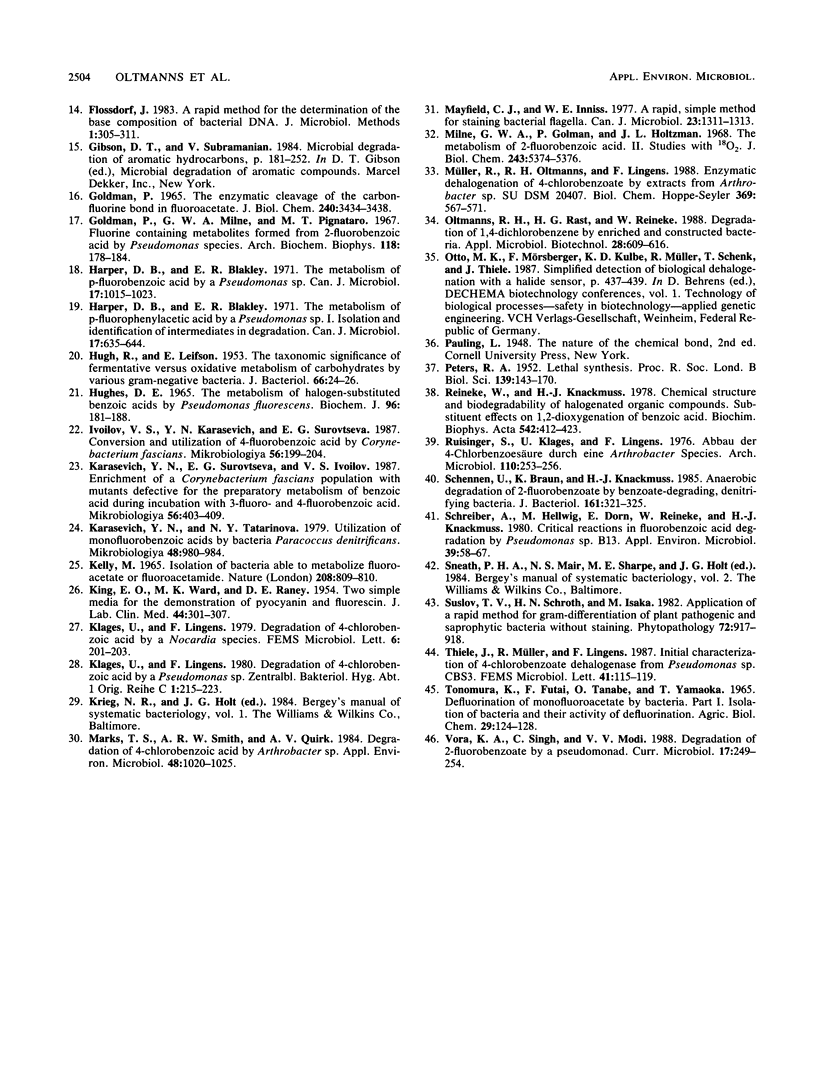
Selected References
These references are in PubMed. This may not be the complete list of references from this article.
- BEHRMAN E. J., STANIER R. Y. Observations on the oxidation of halogenated nicotinic acids. J Biol Chem. 1957 Oct;228(2):947–953. [PubMed] [Google Scholar]
- Cain R. B., Tranter E. K., Darrah J. A. The utilization of some halogenated aromatic acids by Nocardia. Oxidation and metabolism. Biochem J. 1968 Jan;106(1):211–227. doi: 10.1042/bj1060211. [DOI] [PMC free article] [PubMed] [Google Scholar]
- Clarke K. F., Callely A. G., Livingstone A., Fewson C. A. Metabolism of monofluorobenzoates by Acinetobacter calcoaceticus N.C.I.B. 8250. Formation of monofluorocatechols. Biochim Biophys Acta. 1975 Oct 9;404(2):169–179. doi: 10.1016/0304-4165(75)90323-2. [DOI] [PubMed] [Google Scholar]
- Cook A. M., Fewson C. A. Evidence for specific transport mechanisms for aromatic compounds in bacterium N.C.I.B. 8250. Biochim Biophys Acta. 1972 Dec 1;290(1):384–388. doi: 10.1016/0005-2736(72)90081-8. [DOI] [PubMed] [Google Scholar]
- Dagley S. Catabolism of aromatic compounds by micro-organisms. Adv Microb Physiol. 1971;6(0):1–46. doi: 10.1016/s0065-2911(08)60066-1. [DOI] [PubMed] [Google Scholar]
- Dorn E., Hellwig M., Reineke W., Knackmuss H. J. Isolation and characterization of a 3-chlorobenzoate degrading pseudomonad. Arch Microbiol. 1974;99(1):61–70. doi: 10.1007/BF00696222. [DOI] [PubMed] [Google Scholar]
- Engesser K. H., Schmidt E., Knackmuss H. J. Adaptation of Alcaligenes eutrophus B9 and Pseudomonas sp. B13 to 2-Fluorobenzoate as Growth Substrate. Appl Environ Microbiol. 1980 Jan;39(1):68–73. doi: 10.1128/aem.39.1.68-73.1980. [DOI] [PMC free article] [PubMed] [Google Scholar]
- FANSHIER D. W., GOTTWALD L. K., KUN E. STUDIES ON SPECIFIC ENZYME INHIBITORS. VI. CHARACTERIZATION AND MECHANISM OF ACTION OF THE ENZYME-INHIBITORY ISOMER OF MONOFLUOROCITRATE. J Biol Chem. 1964 Feb;239:425–434. [PubMed] [Google Scholar]
- GOLDMAN P. THE ENZYMATIC CLEAVAGE OF THE CARBON-FLUORINE BOND IN FLUOROACETATE. J Biol Chem. 1965 Aug;240:3434–3438. [PubMed] [Google Scholar]
- HUGHES D. E. THE METABOLISM OF HALOGEN-SUBSTITUTED BENZOIC ACIDS BY PSEUDOMONAS FLUORESCENS. Biochem J. 1965 Jul;96:181–188. doi: 10.1042/bj0960181. [DOI] [PMC free article] [PubMed] [Google Scholar]
- HUGH R., LEIFSON E. The taxonomic significance of fermentative versus oxidative metabolism of carbohydrates by various gram negative bacteria. J Bacteriol. 1953 Jul;66(1):24–26. doi: 10.1128/jb.66.1.24-26.1953. [DOI] [PMC free article] [PubMed] [Google Scholar]
- Harper D. B., Blakley E. R. The metabolism of p-fluorobenzoic acid by a Pseudomonas sp. Can J Microbiol. 1971 Aug;17(8):1015–1023. doi: 10.1139/m71-162. [DOI] [PubMed] [Google Scholar]
- Harper D. B., Blakley E. R. The metabolism of p-fluorophenylacetic acid by a Pseudomonas sp. I. Isolation and identification of intermediates in degradation. Can J Microbiol. 1971 May;17(5):635–644. doi: 10.1139/m71-103. [DOI] [PubMed] [Google Scholar]
- KING E. O., WARD M. K., RANEY D. E. Two simple media for the demonstration of pyocyanin and fluorescin. J Lab Clin Med. 1954 Aug;44(2):301–307. [PubMed] [Google Scholar]
- Karasevich Iu N., Tatarinova N. Iu. Utilizatsiia monoftorbenzoinykh kislot bakteriiami Paracoccus denitrificans. Mikrobiologiia. 1979 Nov-Dec;48(6):980–984. [PubMed] [Google Scholar]
- Kelly M. Isolation of bacteria able to metabolize fluoroacetate or fluoroacetamide. Nature. 1965 Nov 20;208(5012):809–810. doi: 10.1038/208809a0. [DOI] [PubMed] [Google Scholar]
- Marks T. S., Smith A. R., Quirk A. V. Degradation of 4-Chlorobenzoic Acid by Arthrobacter sp. Appl Environ Microbiol. 1984 Nov;48(5):1020–1025. doi: 10.1128/aem.48.5.1020-1025.1984. [DOI] [PMC free article] [PubMed] [Google Scholar]
- Mayfield C. I., Inniss W. E. A rapid, simple method for staining bacterial flagella. Can J Microbiol. 1977 Sep;23(9):1311–1313. doi: 10.1139/m77-198. [DOI] [PubMed] [Google Scholar]
- Milne G. W., Goldman P., Holtzman J. L. The metabolism of 2-fluorobenzoic acid. II. Studies with 18-O2. J Biol Chem. 1968 Oct 25;243(20):5374–5376. [PubMed] [Google Scholar]
- Müller R., Oltmanns R. H., Lingens F. Enzymatic dehalogenation of 4-chlorobenzoate by extracts from Arthrobacter sp. SU DSM 20407. Biol Chem Hoppe Seyler. 1988 Jul;369(7):567–571. doi: 10.1515/bchm3.1988.369.2.567. [DOI] [PubMed] [Google Scholar]
- PETERS R. A. Lethal synthesis. Proc R Soc Lond B Biol Sci. 1952 Feb 28;139(895):143–170. doi: 10.1098/rspb.1952.0001. [DOI] [PubMed] [Google Scholar]
- Reddy C. C., Vaidyanathan C. S. Purification and properties of benzoate-4-hydroxylase from a soil pseudomonad. Arch Biochem Biophys. 1976 Dec;177(2):488–498. doi: 10.1016/0003-9861(76)90460-4. [DOI] [PubMed] [Google Scholar]
- Reineke W., Knackmuss H. J. Chemical structure and biodegradability of halogenate aromatic compounds. Substituent effects on 1,2-dioxygenation of benzoic acid. Biochim Biophys Acta. 1978 Sep 6;542(3):412–423. doi: 10.1016/0304-4165(78)90372-0. [DOI] [PubMed] [Google Scholar]
- Ruisinger S., Klages U., Lingens F. Abbau der 4-chlorbenzoesäure durch eine Arthrobacter-Species. Arch Microbiol. 1976 Nov 2;110(23):253–256. doi: 10.1007/BF00690235. [DOI] [PubMed] [Google Scholar]
- Schennen U., Braun K., Knackmuss H. J. Anaerobic degradation of 2-fluorobenzoate by benzoate-degrading, denitrifying bacteria. J Bacteriol. 1985 Jan;161(1):321–325. doi: 10.1128/jb.161.1.321-325.1985. [DOI] [PMC free article] [PubMed] [Google Scholar]
- Schreiber A., Hellwig M., Dorn E., Reineke W., Knackmuss H. J. Critical Reactions in Fluorobenzoic Acid Degradation by Pseudomonas sp. B13. Appl Environ Microbiol. 1980 Jan;39(1):58–67. doi: 10.1128/aem.39.1.58-67.1980. [DOI] [PMC free article] [PubMed] [Google Scholar]


